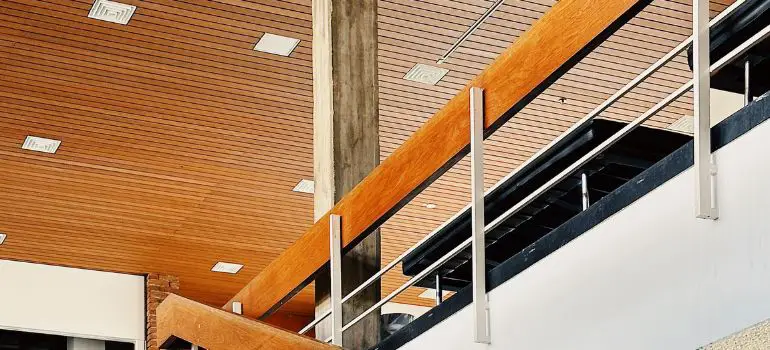Tools and Materials
Before you start, make sure you have the following tools and materials ready:
- Tongue and groove ceiling boards
- Measuring tape
- Circular saw
- Nails and a nail gun
- Safety goggles and gloves
- Ladder or scaffolding
- Paint and sealing materials
Measuring and Planning
To achieve a staggered pattern, it’s crucial to measure your ceiling’s dimensions accurately. Plan the layout by marking the centerline and deciding how much of each board should extend past the center.
Safety Precautions
- Wear Safety Gear: Always wear the appropriate safety gear, including safety goggles to protect your eyes from dust and debris, gloves to safeguard your hands, and ear protection if you’re using loud power tools.
- Secure Your Ladder or Scaffolding: Ensure that your ladder or scaffolding is placed on a stable and level surface. Use the appropriate ladder or platform height for the job, and follow the manufacturer’s instructions for setup and use.
- Use the Right Tools: Use the correct tools for the job and ensure they are in good working condition. A circular saw, nail gun, and measuring tools are common tools needed for a staggered ceiling installation.
- Follow Manufacturer Instructions: Read and follow the manufacturer’s instructions for all tools and materials, including tongue and groove boards, sealants, and paints. This ensures safe and effective usage.
- Beware of Electrical Wiring: Before you start, be aware of the location of any electrical wiring or fixtures in the ceiling. Avoid drilling or cutting near electrical components to prevent accidents.
- Work with a Partner: If possible, have a friend or family member assist you. They can help with holding boards in place, handing you tools, and providing support when working at heights.
- Proper Ventilation: If you’re working in an enclosed space, ensure adequate ventilation to disperse fumes from paints, sealants, or adhesives. Use a mask if necessary to protect against inhaling harmful chemicals.
- Mind Your Step: Be mindful of your footing when working on ladders or scaffolding. Avoid overreaching, and never stand on the top rung of a ladder.
- Secure Loose Clothing: Tie back long hair and avoid wearing loose clothing that could get caught in power tools or machinery.
- Keep the Workspace Clean: Maintain a tidy workspace by clearing away debris and keeping tools organized. A clutter-free area reduces the risk of tripping or falling.
- First Aid Kit: Have a well-stocked first aid kit readily available in case of minor injuries. Ensure you know how to use it or have someone on hand who does.
- Emergency Plan: Discuss an emergency plan with your partner or someone in your household. Know the location of fire extinguishers, emergency exits, and how to contact emergency services if needed.
- Stay Hydrated: Home improvement projects can be physically demanding. Stay hydrated by drinking water regularly, especially if you’re working in a hot or humid environment.
- Take Breaks: Don’t overexert yourself. Take regular breaks to rest and recharge, especially if your project spans several days.
- Prioritize Safety over Speed: While it’s important to complete your project efficiently, safety should always come first. Avoid rushing through tasks and take your time to do them correctly.
Preparing the Ceiling
Ensure your ceiling is clean and free of any debris. It should also be dry to prevent future issues like warping.
Starting the Staggered Pattern
Begin by marking the centerline of your ceiling using a chalk line or a straightedge. This will serve as your guide throughout the installation process.
Installing the First Row
Attach the first row of tongue and groove boards along the centerline. Use a nail gun to secure them in place.
Cutting and Fitting

- Measure Twice, Cut Once: Before cutting any boards, measure the space where they will be installed accurately. Double-check your measurements to ensure precision.
- Safety First: Put on safety goggles and gloves to protect yourself from dust and splinters while cutting and handling wood.
- Set Up Your Tools: If you’re using a circular saw, make sure it is equipped with a fine-toothed blade suitable for cutting wood. Adjust the blade depth to slightly deeper than the thickness of the tongue and groove boards.
- Mark the Cut Lines: Use a pencil and a straightedge to mark the cut lines on the boards based on your measurements. For a staggered pattern, ensure that you cut the boards at varying lengths to achieve the desired effect.
- Cutting the Boards: Secure the tongue and groove board on a stable surface, such as sawhorses or a workbench. Position the board so that the marked cut line is aligned with the edge of the surface, and ensure that it won’t move during cutting. Hold the circular saw firmly with both hands and make the cut along the marked line. Take your time and cut slowly to ensure a clean and precise cut.
- Test Fit: After cutting the board, test-fit it in place to check for proper alignment and fit. If needed, make adjustments to the cut before proceeding.
- Stagger the Seams: To maintain a visually pleasing staggered pattern, ensure that the seams of adjacent boards do not align vertically. The staggered effect should create an irregular, visually interesting layout.
- Secure the Boards: Once you are satisfied with the fit and alignment, use a nail gun to secure the tongue and groove boards to the ceiling. Drive nails at an angle through the tongue portion of each board to conceal them.
- Repeat the Process: Continue measuring, cutting, and fitting tongue and groove boards one row at a time, ensuring that the staggered pattern remains consistent. Remember to vary the lengths of the boards for a more dynamic appearance.
- Trim for Corners: When you reach corners or edges, you may need to make precise cuts to ensure a seamless finish. Use a miter saw to cut the boards at the appropriate angles, allowing them to fit snugly into place.
- Fill Gaps and Joints: Inspect the installed boards for any small gaps or joints that may have formed during installation. Fill these gaps with wood filler and sand them smooth to create a seamless look.
- Check for Level: Periodically use a level to ensure that your staggered ceiling is even and level. Make any necessary adjustments to maintain a straight and uniform appearance.
Continuing the Pattern
Work row by row, staggering the boards and maintaining a consistent pattern. Double-check your measurements as you go to maintain precision.
Dealing with Corners
When reaching corners, carefully measure and cut the boards to fit the angles. A miter saw may be helpful for achieving clean cuts.
Finishing Touches
Once the staggered pattern is complete, add any finishing touches, such as trim or molding, to give your ceiling a polished look.
Sealing and Painting
To protect your tongue and groove ceiling and enhance its appearance, apply a sealant and your desired paint color.
Maintenance
- Regular Cleaning: Dust and dirt can accumulate on your ceiling over time. Use a soft-bristle brush or a vacuum cleaner with a brush attachment to gently remove dust and cobwebs. Be careful not to scratch the wood surface.
- Occasional Washing: For more thorough cleaning, mix a mild detergent with water and use a soft cloth or sponge to gently wipe down the ceiling. Avoid using excessive water, as wood can warp when exposed to moisture for extended periods. Dry the ceiling thoroughly after cleaning.
- Inspect for Damage: Periodically inspect your ceiling for any signs of damage, such as cracks, dents, or loose boards. Address any issues promptly to prevent further deterioration.
- Reapply Sealant and Paint: Depending on the type of finish you applied during installation, you may need to reapply a sealant or repaint your ceiling every few years. This not only enhances its appearance but also provides added protection against moisture and wear.
- Maintain Proper Ventilation: Ensure that the room where the staggered ceiling is installed has proper ventilation. Good airflow helps prevent moisture buildup, which can lead to mold and wood damage.
- Control Humidity: If you live in an area with fluctuating humidity levels, consider using a dehumidifier or humidifier to maintain stable humidity within the recommended range for wood products.
- Inspect for Insects: Wood ceilings can be susceptible to wood-boring insects. Periodically inspect your ceiling for any signs of infestation, such as small holes or sawdust-like debris. If you suspect an issue, consult a pest control professional.
- Avoid Harsh Chemicals: When cleaning or performing maintenance, avoid using harsh chemicals or abrasive cleaning agents. These can damage the finish and the wood itself. Stick to mild, wood-friendly cleaners.
- Check for Loose Nails: Over time, nails used to secure the tongue and groove boards may loosen due to natural wood expansion and contraction. Periodically check for loose nails and secure them as needed to prevent sagging boards.
- Regularly Dust Light Fixtures: If you have light fixtures installed on your staggered ceiling, be sure to dust them regularly. Clean fixtures provide better illumination and prevent dust from settling on the ceiling surface.
- Maintain a Safe Environment: Keep the area around your staggered ceiling clear of any potential hazards. Avoid hanging heavy objects from the ceiling, as this can strain the boards and compromise their integrity.
- Professional Inspection: Consider having a professional carpenter or contractor inspect your staggered ceiling every few years. They can identify any structural issues or maintenance needs that you might have missed.
Benefits of a Staggered Ceiling
- Visual Appeal: A staggered ceiling immediately grabs attention and adds a touch of sophistication to any room. The irregular pattern creates a dynamic visual interest that can elevate the overall aesthetics of your living space.
- Unique Design: Staggered ceilings are not as common as traditional flat ceilings, making them a unique and eye-catching feature in your home. They allow you to express your individual style and creativity in interior design.
- Acoustic Insulation: The natural properties of wood make staggered tongue and groove ceilings excellent at sound absorption. This can improve the acoustics in the room, reducing echoes and creating a more pleasant auditory environment.
- Conceals Imperfections: If your ceiling has minor imperfections, such as uneven surfaces or cracks, a staggered pattern can effectively conceal these flaws, giving your ceiling a smoother and more refined appearance.
- Enhanced Lighting: The shadows and depth created by a staggered ceiling can enhance the play of light and shadows in the room. This effect can make your space feel cozier and more inviting.
- Customization: Staggered ceilings offer flexibility in design. You can choose the degree of staggering, the type of wood, and the finish to match your desired interior decor, whether it’s rustic, contemporary, or traditional.
- Warmth and Comfort: Wood ceilings inherently exude warmth and coziness. A staggered tongue and groove ceiling can make a room feel more inviting and comfortable, making it an ideal addition to living rooms, bedrooms, or even porches.
- Increased Property Value: A well-executed staggered ceiling can increase the resale value of your home. Potential buyers often appreciate unique architectural features, which can make your property more appealing in the real estate market.
- Longevity and Durability: High-quality tongue and groove boards are known for their durability and resistance to wear and tear. With proper maintenance, a staggered ceiling can last for many years, making it a wise investment.
- Easy Maintenance: Regular maintenance for a staggered ceiling primarily involves dusting and occasional cleaning. Unlike some other ceiling materials, wood is relatively easy to maintain.
Common Mistakes to Avoid
- Inaccurate Measurements: One of the most critical errors is inaccurate measurements. Failing to measure and cut your tongue and groove boards precisely can result in uneven spacing, gaps, or boards that don’t fit correctly. Always double-check your measurements before cutting.
- Ignoring Safety Precautions: Safety should be a top priority. Skipping safety gear such as goggles, gloves, and ear protection can lead to accidents. Also, ensure your ladder or scaffolding is stable to prevent falls.
- Poor Planning: Rushing into the project without proper planning can lead to costly mistakes. Take the time to plan your staggered ceiling layout, including the centerline and how the boards will align. A well-thought-out plan can save you time and frustration.
- Neglecting the Ceiling’s Condition: Installing tongue and groove boards on a damaged or moist ceiling can lead to future issues. Make sure your ceiling is dry, clean, and in good condition before starting the project.
- Inadequate Ventilation: Overlooking ventilation in the room can result in moisture buildup, which can damage the wood and lead to mold growth. Ensure your room has adequate ventilation to prevent these problems.
- Uneven Spacing: Maintaining consistent spacing between boards is crucial for achieving a visually appealing staggered pattern. Using spacers or guides can help you keep the spacing uniform.
- Skipping Primer and Sealing: Skipping the primer and sealing steps can leave your ceiling vulnerable to moisture, which can cause the wood to warp or rot over time. Always apply the necessary sealant and paint to protect your ceiling.
- Not Accounting for Lighting Fixtures: Failing to plan for lighting fixtures can lead to complications when it’s time to install them. Ensure that your staggered ceiling design accommodates lighting fixtures seamlessly.
- Neglecting Proper Finishing: Rushing through the finishing touches can make your staggered ceiling look incomplete. Add trim or molding as needed to give your ceiling a polished appearance.
- Lack of Practice: If you’re new to DIY projects, not practicing cutting and fitting tongue and groove boards on scrap pieces can lead to costly mistakes on your actual ceiling. Take the time to practice and refine your skills before starting the project.
Additional Tips for a Stunning Staggered Ceiling
Achieving a staggered tongue and groove ceiling can be a rewarding DIY project. To make your project even more successful, consider these additional tips:
- Select Quality Materials: Invest in high-quality tongue and groove boards. Choose wood that matches your decor and complements the room’s aesthetics.
- Maintain Consistency: Consistency is key to a stunning staggered ceiling. Ensure that each row follows the same pattern, and double-check your measurements to prevent gaps or misalignment.
- Secure Adequate Ventilation: Proper ventilation is essential to prevent moisture buildup, which can lead to mold and damage over time. Make sure your room has sufficient airflow.
- Plan Lighting Placement: Consider your lighting fixtures when planning your staggered ceiling. Ensure that your fixtures align with the board layout for a harmonious look.
- Test Your Skills: If you’re new to DIY projects, practice cutting and fitting tongue and groove boards on scrap pieces before working on your ceiling.
- Seek Inspiration: Browse design magazines, websites, or consult with an interior designer to gather inspiration for your staggered ceiling design. This can help you create a unique and visually appealing layout.
Conclusion
Staggering tongue and groove ceiling boards can transform your living space into a visually appealing masterpiece. With the right tools, careful planning, and attention to detail, you can achieve a unique and elegant ceiling design that will impress anyone who enters your home.
FAQs
- How long does it take to stagger a tongue and groove ceiling?
- The time required depends on the size of the area and your experience, but it usually takes a few days to complete.
- Can I install a staggered ceiling by myself, or do I need professional help?
- While it is possible to do it yourself, having some carpentry experience is beneficial. If you’re unsure, consulting a professional is a good idea.
- What type of wood is best for a tongue and groove ceiling?
- Cedar, pine, and cypress are popular choices for tongue and groove ceilings due to their durability and aesthetic appeal.
- Do I need to seal the ceiling after installation?
- Yes, sealing the ceiling is essential to protect it from moisture and ensure its longevity.
- Can I paint a staggered tongue and groove ceiling any color I like?
- Yes, you can choose any paint color that suits your design preferences and complements your room’s decor.



